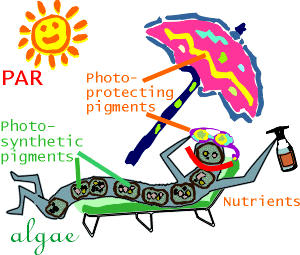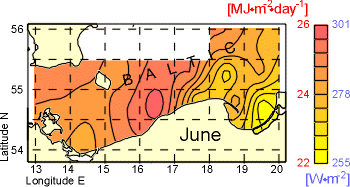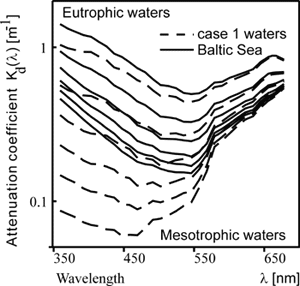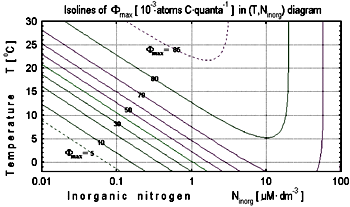L A B O R A T O R Y
![]()
![]()
|
The investigation and
modelling
|
 |
The People:
Assoc. Prof. Bogdan Wočniak Head of the Marine Physics Department and the Laboratory
Prof. Jerzy Dera Director of the Institute
Our works:
We deal with experimental studies and theoretical analysis of radiation
fluxes in the sea-atmosphere system. Mainly we are interested in inherent
and apparent optical properties of seawater components and their influence
on solar energy distribution within water body especially the part of energy
utilised in primary production process.
| We are able to model main radiant
energy fluxes in the sea-atmosphere system
(monthly means of 15 energy fluxes for the Southern Baltic region) (Wočniak et al. 1996,
|
|

Spatial distribution of solar energy absorbed in water body in July |
In the very centre of our concern are complex
models of photosynthesis valid for all types of natural water (Wočniak
et al. 1992, Dera 1995, Wočniak
et al. 1997, Wočniak
and Dera 2000). Such models are elaborated to estimate the primary
production quantity by using remote sensing methods and to predict ecosystems
functioning. In order to develop the models we are investigating and modelling:
(sea waters classifications for case 1 water and case 2 water by Wočniak) (Wočniak and Pelevin 1991, Wočniak et al. 1995 Kaczmarek and Wočniak 1995);
|
|

Modelled spectra of downward attenuation coefficient
|
|
(model characteristic of the specific absorption Gaussian bands of pigments) (Wočniak and Ostrowska, 1990, Wočniak et al. 1998); (statistical model of marine phytoplankton
absorption and fluorescence capacities taking into account acclimation
processes, pigment package effects and environmental factor)
|

Specific light absorption by pigments in photosynthetic apparatus of phytoplankton cells
|
||
(Wočniak et al. 1992, Wočniak et al. 1997 Ficek et al. 2000a,b). |

The Fmax quantum yield of carbon fixation dependence on temperature and inorganic nitrogen concentration |
||
To achieve these aims we carry out the measurements of light attenuation coefficients, pigments concentration, absorption properties of water seawater components, primary production, fluorescence of phytoplankton photosynthetic apparatus. We have collaborated with scientists from PP Shirshov Institute of Oceanology RAS in Moscow and Department of Biophysics Faculty of Biology Moscow State University (Wočniak, 1991), and others. Our researches are performed within several international projects, e.g. BALTEX, BIOCOLOR.
Literature:
Dera J., 1995, Underwater irradiance as a factor affecting primary production, Dissertations and monographs, 7, Institute of Oceanology PAS, Sopot, 110 pp.;
Ficek D., Majchrowski R., Ostrowska M., Wočniak B., 2000, Influence of non-photosynthetic pigments on the measured quantum yield of photosynthesis, Oceanologia, 42 (2), 231-242;
Ficek D., Ostrowska M., Kuzio M., Pogosyan S. I., 2000, Variability of the portion of functional PS2 reaction centres in the light of fluorometric study, Oceanologia, 42 (2), 243-250;
Kaczmarek S., Wočniak B., 1995, The application of the optical classification of waters in the Baltic Sea investigation (Case 2 waters), Oceanologia 37 (2), 285-297;
Kaczmarek S., Dera J., 1998, Radiation flux balance of the sea-atmosphere system over the Southern Baltic Sea, Oceanologia, 40 (4), 1-30;
Majchrowski R., Ostrowska M., 2000, Influence of photo- and chromatic acclimation on pigment composition in the sea, Oceanologia, 42 (2), 157-175;
Majchrowski R., Wočniak B., Dera J., Ficek D., Kaczmarek S., Ostrowska M., Koblentz-Mishke O. I., 2000, Model of the 'in vivo' spectral absorption of algal pigments. Part 2. Practical applications of the model, Oceanologia, 42 (2), 191-202;
Ostrowska M., Majchrowski R., Matorin D. N., Wočniak B., 2000, Variability of the specific fluorescence of chlorophyll in the ocean. Part 1. Theory of classical `in situ' chlorophyll fluorometry, Oceanologia, 42 (2), 203-219;
Ostrowska M., Matorin D. N., Ficek D., 2000, Variability of the specific fluorescence of chlorophyll in the ocean. Part 2. Fluorometric method of chlorophyll a determination, Oceanologia, 42 (2), 221-229;
Wočniak B., Ostrowska M., 1990, Optical absorption properties of phytoplankton in various seas, Oceanologia, 29, 117-146;
Wočniak B., 1991, Formation of the working group C-1. Application of physical (satellite and fluorescence) methods for studies of marine primary production and marine ecosystem functioning processes, (February 19-21, 1991, Sopot, Poland), Oceanologia, 30, 143-144;
Wočniak B., Pelevin V. N., 1991, Optical classifications of the seas in relation to phytoplankton characteristics, Oceanologia, 31, 25-55;
Wočniak B., Dera J., Koblentz-Mishke O.J., 1992, Modelling the relationship between primary production, optical properties, and nutrients in the sea, in: Ocean Optics XI, SPIE, 1992. v.1750, 246-275;
Wočniak B., Dera J., Semovski S., Hapter R., Ostrowska M., Kaczmarek S., 1995, Algorithm for estimating primary production in the Baltic by remote sensing, SiMO, 68 (8), 91-123;
Wočniak B., Rozwadowska A., Kaczmarek S., Wočniak S. B., Ostrowska M., 1996, Seasonal variability of the solar radiation flux and its utilisation in the South Baltic, Baltic Marine Science Conference, R÷nne, Denmark, 21-26 October;
Wočniak B., Dera J., Majchrowski R., Ficek D., Koblentz-Mishke O. I., Darecki M., 1997, IO PAS initial model of marine primary production for remote sensing application, Oceanologia, 39 (4), 377-395;
Wočniak B., Dera J., Ficek D., Majchrowski R., Kaczmarek S., Ostrowska M., Koblentz-Mishke O. I., 1998, Modelling the influence of photo- and chromatic - acclimation on the absorption properties of marine phytoplankton, Ocean Optics Conference, Kailua-Kona, Hawaii, USA, 10-13 November 1998;
Wočniak B., Dera J., 2000,
Luminescence and photosynthesis of marine phytoplankton - a brief presentation
of new results, Oceanologia,
42 (2), 137-156;
Wočniak B., Dera J., Ficek D., Majchrowski R., Kaczmarek S., Ostrowska M., Koblentz-Mishke O. I., 2000, Model of the `in vivo' spectral absorption of algal pigments. Part 1. Mathematical apparatus, Oceanologia, 42 (2), 177-190.